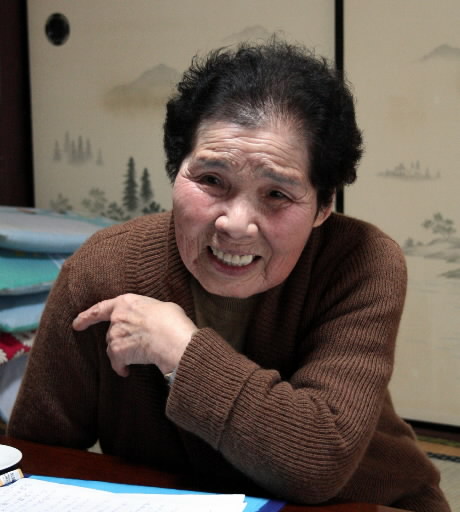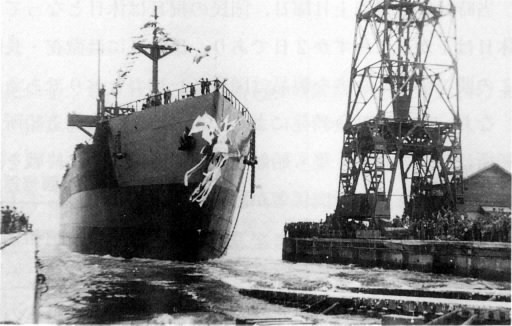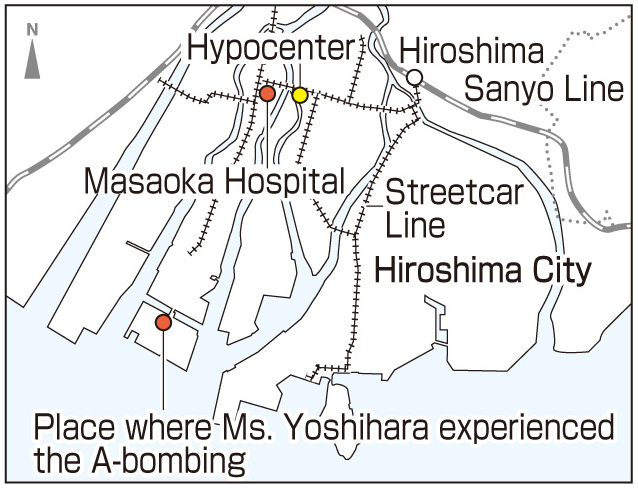Hiroe Yoshihara, 86, Kochi, Higashihiroshima City
Jan. 30, 2013
Conscripted work led to a narrow escape
Unable to forget the fire for cremating the dead
During the war, Hiroe Yoshihara (nee Takahashi), 86, was a midwife, living and working at Masaoka Hospital. The hospital was located in Nekoyacho, part of present-day Naka Ward, only 500 meters from the hypocenter. However, on August 6, 1945, the day of the atomic bombing, Ms. Yoshihara was mobilized for the war effort and was assigned to serve as a nurse at a hospital on the grounds of the Hiroshima Shipyard of Mitsubishi Heavy Industries. Because this hospital was located in Eba, about 4 kilometers from the hypocenter, she managed to survive the blast.
Ms. Yoshihara left Masaoka Hospital at around 7:30 on the morning of the bombing. She took a streetcar, got off at the Eba stop, then walked to the hospital. At 8:15, she was changing from her monpe (old-fashioned Japanese-style work pants for women) into a white nurse’s uniform. At that instant, as she heard a voice shouting that a B-29 bomber was overhead, she saw a great flash in the sky. Thinking she should move to an air-raid shelter, she went into the corridor and was hit by a powerful wind blowing in from outside the building. She dived to the floor.
Shortly after, she was heading to the air-raid shelter outside the building when she was summoned: “There are wounded coming! You’re needed right away!”
When she entered an examination room, she found that medical equipment and antiseptic solution had been knocked over and the room was in disarray. Still, the injured came, one after the other. Many had been burned, skin from their faces and hands now peeling and dangling down. Ms. Yoshihara dabbed some zinc oxide oil on their wounds.
But the number of wounded overwhelmed the hospital and many had to be laid outside on the ground. Recalled Ms. Yoshihara: “It was a very hot day in August and they were basically left to die. When we checked on them, many were dead.” The victims’ bodies were then carried to the beach and burned. The fire used to cremate the bodies blazed on and on. “Even now, it’s like I can still see that fire,” she said, tears in her eyes.
In addition to her efforts at the hospital on the grounds of Mitsubishi Heavy Industries, Ms. Yoshihara, along with the doctor Akira Masaoka, tended to patients at a dormitory for workers from Korea and at Eba National School (now Eba Elementary School).
On August 15, she returned to her parents’ home in the village of Toyosaka (part of today’s Higashihiroshima City). There, she suffered from severe diarrhea and was unable to rise from her bed for a week. After she recovered, she went back to the Mitsubishi hospital and worked there until December 1945.
Since that time, for the past 67 years, Ms. Yoshihara has lived without serious illness. She has led a vigorous life, working in gynecology in Higashihiroshima City until May 2011. She believes this is because, during the week she suffered from diarrhea, the poisonous radiation from the atomic bomb was removed from her body.
“I’m getting old, so I should talk about my experience so it can be handed down to the next generation to help make a peaceful world,” she explained. For this article, she spoke about her A-bomb experience for the first time.
In preparing for this article, she made notes about her experience and later spotted one of her grandchildren, a second-year student in junior high whom she lives with, eagerly reading these memories. “There should be peace in the world,” she said. “There should never be another war.” This is her hope for the next generation. (Rie Nii, Staff Writer)
Mitsubishi Heavy Industries, Hiroshima Shipyard: Produced manned torpedoes in 1945
Mitsubishi Heavy Industries has two plants along the coast of Hiroshima City. One of them is in Ebaokimachi, part of Naka Ward, and was called “Mitsubishi Heavy Industries, Hiroshima Shipyard” during the war.
The Eba shoreline was reclaimed in order to build the plant, which officially opened in March 1944. The other plant in Minamikannonmachi (today’s Nishi Ward) was established at the same time, and was called “Hiroshima Machinery Works.”
In June 1944, the Hiroshima Shipyard completed its first ship, the Hisakawamaru, which then set sail. From April 1945, the plant began producing one-man torpedoes that made suicide attacks on enemy ships. Around this time, to prepare for possible air raids, factories were being “evacuated” from the city and the Hiroshima Shipyard’s machinery was moved to Mt. Sarayama and to Kabe, in today’s Asakita Ward.
According to a report on the A-bomb damage in Hiroshima, the number of people working at the two plants, at the time of the bombing, was approximately 9,200. About 3,200 of them were mobilized students, while the others were young women and Korean workers. Three people died at the plants, and another 40 were killed in the city center while helping to dismantle homes to create a fire lane in the event of air raids.
Teenagers’ Impressions
Knowing the horror of militarism
During the war, Ms. Yoshihara thought that working for the war effort was an “honor.” The idea of conscription seemed like a natural thing at the time. From her story, I felt the horror of militarism.
We have to make an effort to create a world without war. To do that, we should learn about the history of war and recognize the horror of war clearly. (Yuji Iguchi, 15)
Show an interest in politics
I imagine it must have been so hard to keep a cool head after the bombing, but Ms. Yoshihara helped nurse the injured in the aftermath of the blast. I really admire her.
In order to eliminate war from this world, I think it’s important to show an interest in politics and consider what kinds of policies would be best. When I’m old enough, I plan to vote for candidates who are against war. (Arisa Shiromoto, 16)
Staff Writer’s Notebook
After graduating from Morimoto Girls’ School in the village of Kawamoto (part of present-day Higashihiroshima City), Hiroe Yoshihara attended a training school for midwives located in Nishikannon (part of today’s Nishi Ward). She had actually wanted to become a school teacher. Because a teacher at her girls’ school told her that the higher normal school [teachers’ college] in the city of Mihara would be too difficult for her to enter, she decided to go to a similar school in Korea. However, as she was preparing to go there, the war intensified and ships stopped sailing to Korea. Thus, she was forced to abandon her journey. “If I had gone to Korea, I might not have returned to Hiroshima,” she said. “We can’t foresee our fate.”
For some time after the war, she continued working at the hospital at the Hiroshima Shipyard of Mistubishi Heavy Industries. But at the end of 1945, her brother, who was 21 years older than her, said he was concerned. “We’re afraid of what the soldiers of the Allied Forces will do to women,” he explained, picking her up. “You have to return home.” Ms. Yoshihara then worked for a while at a midwifery home in the town of Kochi (in today’s Higashihiroshima City), near her home, and in 1949, she got married and established her own midwifery home. She had delivered more than 300 babies by the time a maternity clinic opened in the town in 1965.
Ms. Yoshihara says that she knows well the value of human life. “We should never have another war like that again,” she said. “This is a happy time now, and I hope it continues for a long, long time. War brings suffering to everyone.” These are words that come from the lessons of personal experience. (Rie Nii)
(Originally published on January 14, 2013)
Unable to forget the fire for cremating the dead
During the war, Hiroe Yoshihara (nee Takahashi), 86, was a midwife, living and working at Masaoka Hospital. The hospital was located in Nekoyacho, part of present-day Naka Ward, only 500 meters from the hypocenter. However, on August 6, 1945, the day of the atomic bombing, Ms. Yoshihara was mobilized for the war effort and was assigned to serve as a nurse at a hospital on the grounds of the Hiroshima Shipyard of Mitsubishi Heavy Industries. Because this hospital was located in Eba, about 4 kilometers from the hypocenter, she managed to survive the blast.
Ms. Yoshihara left Masaoka Hospital at around 7:30 on the morning of the bombing. She took a streetcar, got off at the Eba stop, then walked to the hospital. At 8:15, she was changing from her monpe (old-fashioned Japanese-style work pants for women) into a white nurse’s uniform. At that instant, as she heard a voice shouting that a B-29 bomber was overhead, she saw a great flash in the sky. Thinking she should move to an air-raid shelter, she went into the corridor and was hit by a powerful wind blowing in from outside the building. She dived to the floor.
Shortly after, she was heading to the air-raid shelter outside the building when she was summoned: “There are wounded coming! You’re needed right away!”
When she entered an examination room, she found that medical equipment and antiseptic solution had been knocked over and the room was in disarray. Still, the injured came, one after the other. Many had been burned, skin from their faces and hands now peeling and dangling down. Ms. Yoshihara dabbed some zinc oxide oil on their wounds.
But the number of wounded overwhelmed the hospital and many had to be laid outside on the ground. Recalled Ms. Yoshihara: “It was a very hot day in August and they were basically left to die. When we checked on them, many were dead.” The victims’ bodies were then carried to the beach and burned. The fire used to cremate the bodies blazed on and on. “Even now, it’s like I can still see that fire,” she said, tears in her eyes.
In addition to her efforts at the hospital on the grounds of Mitsubishi Heavy Industries, Ms. Yoshihara, along with the doctor Akira Masaoka, tended to patients at a dormitory for workers from Korea and at Eba National School (now Eba Elementary School).
On August 15, she returned to her parents’ home in the village of Toyosaka (part of today’s Higashihiroshima City). There, she suffered from severe diarrhea and was unable to rise from her bed for a week. After she recovered, she went back to the Mitsubishi hospital and worked there until December 1945.
Since that time, for the past 67 years, Ms. Yoshihara has lived without serious illness. She has led a vigorous life, working in gynecology in Higashihiroshima City until May 2011. She believes this is because, during the week she suffered from diarrhea, the poisonous radiation from the atomic bomb was removed from her body.
“I’m getting old, so I should talk about my experience so it can be handed down to the next generation to help make a peaceful world,” she explained. For this article, she spoke about her A-bomb experience for the first time.
In preparing for this article, she made notes about her experience and later spotted one of her grandchildren, a second-year student in junior high whom she lives with, eagerly reading these memories. “There should be peace in the world,” she said. “There should never be another war.” This is her hope for the next generation. (Rie Nii, Staff Writer)
Hiroshima Insight
Mitsubishi Heavy Industries, Hiroshima Shipyard: Produced manned torpedoes in 1945
Mitsubishi Heavy Industries has two plants along the coast of Hiroshima City. One of them is in Ebaokimachi, part of Naka Ward, and was called “Mitsubishi Heavy Industries, Hiroshima Shipyard” during the war.
The Eba shoreline was reclaimed in order to build the plant, which officially opened in March 1944. The other plant in Minamikannonmachi (today’s Nishi Ward) was established at the same time, and was called “Hiroshima Machinery Works.”
In June 1944, the Hiroshima Shipyard completed its first ship, the Hisakawamaru, which then set sail. From April 1945, the plant began producing one-man torpedoes that made suicide attacks on enemy ships. Around this time, to prepare for possible air raids, factories were being “evacuated” from the city and the Hiroshima Shipyard’s machinery was moved to Mt. Sarayama and to Kabe, in today’s Asakita Ward.
According to a report on the A-bomb damage in Hiroshima, the number of people working at the two plants, at the time of the bombing, was approximately 9,200. About 3,200 of them were mobilized students, while the others were young women and Korean workers. Three people died at the plants, and another 40 were killed in the city center while helping to dismantle homes to create a fire lane in the event of air raids.
Teenagers’ Impressions
Knowing the horror of militarism
During the war, Ms. Yoshihara thought that working for the war effort was an “honor.” The idea of conscription seemed like a natural thing at the time. From her story, I felt the horror of militarism.
We have to make an effort to create a world without war. To do that, we should learn about the history of war and recognize the horror of war clearly. (Yuji Iguchi, 15)
Show an interest in politics
I imagine it must have been so hard to keep a cool head after the bombing, but Ms. Yoshihara helped nurse the injured in the aftermath of the blast. I really admire her.
In order to eliminate war from this world, I think it’s important to show an interest in politics and consider what kinds of policies would be best. When I’m old enough, I plan to vote for candidates who are against war. (Arisa Shiromoto, 16)
Staff Writer’s Notebook
After graduating from Morimoto Girls’ School in the village of Kawamoto (part of present-day Higashihiroshima City), Hiroe Yoshihara attended a training school for midwives located in Nishikannon (part of today’s Nishi Ward). She had actually wanted to become a school teacher. Because a teacher at her girls’ school told her that the higher normal school [teachers’ college] in the city of Mihara would be too difficult for her to enter, she decided to go to a similar school in Korea. However, as she was preparing to go there, the war intensified and ships stopped sailing to Korea. Thus, she was forced to abandon her journey. “If I had gone to Korea, I might not have returned to Hiroshima,” she said. “We can’t foresee our fate.”
For some time after the war, she continued working at the hospital at the Hiroshima Shipyard of Mistubishi Heavy Industries. But at the end of 1945, her brother, who was 21 years older than her, said he was concerned. “We’re afraid of what the soldiers of the Allied Forces will do to women,” he explained, picking her up. “You have to return home.” Ms. Yoshihara then worked for a while at a midwifery home in the town of Kochi (in today’s Higashihiroshima City), near her home, and in 1949, she got married and established her own midwifery home. She had delivered more than 300 babies by the time a maternity clinic opened in the town in 1965.
Ms. Yoshihara says that she knows well the value of human life. “We should never have another war like that again,” she said. “This is a happy time now, and I hope it continues for a long, long time. War brings suffering to everyone.” These are words that come from the lessons of personal experience. (Rie Nii)
(Originally published on January 14, 2013)










